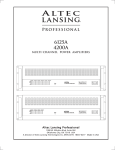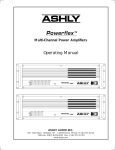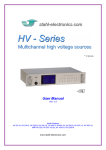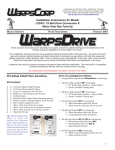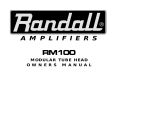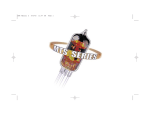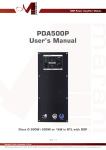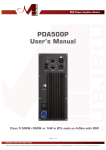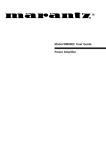Download Marantz MM9360 Operating instructions
Transcript
Model MM9340 Model MM9360 Power Amplifier The lightning flash with arrowhead symbol, within an equalateral triangle, is intended to alert the user to the presence of uninsulated "dangerous voltage" within the product's enclosure that may be of sufficient magnitude to constitute a risk of electric shock to persons. The exclamation point within an equalateral triangle is intended to alert the user to the presence of important operating and maintenance instructions in the literature accompanying the device. TO REDUCE THE RISK OF ELECTRIC SHOCK, DO NOT REMOVE COVER. NO USER SERVICEABLE PARTS INSIDE. REFER SERVICING TO QUALIFIED SERVICE PERSONNEL. TO REDUCE THE RISK OF FIRE OR ELECTRICAL SHOCK, DO NOT EXPOSE THIS APPLIANCE TO RAIN OR MOISTURE. TO REDUCE THE RISK OF FIRE, REPLACE ONLY WITH SAME TYPE FUSE. REFER REPLACEMENT TO QUALIFIED SERVICE PERSONNEL. WARNING: THIS APPARATUS MUST BE EARTHED THROUGH THE SUPPLIED POWER LINE CORD 2 SAFETY INSTRUCTIONS READ BEFORE OPERATING EQUIPMENT This product was designed and manufactured to meet strict quality and safety standards. There are, however, some installation and operation precautions which you should be particularly aware of. 1. Read Instructions - All the safety and operating instructions should be read before the appliance is operated. 2. Retain Instructions - The safety and operating instructions should be retained for future reference. 11. Power Sources - The appliance should be connected to a power supply only of the type described in the operating instructions or as marked on the appliance. 12. Grounding or Polarization - The precautions that should be taken so that the grounding or polarization means of an appliance is not defeated. 3. Heed Warnings - All warnings on the appliance and in the operating instructions should be adhered to. 13. Power-Cord Protection - Power-supply cords should be routed so that they are not likely to be walked on or pinched by items placed upon or against them, paying particular attention to cords at plugs, convenience receptacles, and the point where they exit from the appliance. 4. Follow Instructions - All operating and use instructions should be followed. 14. Cleaning - The appliance should be cleaned only as recommended by the manufacturer. 5. Water and Moisture - The appliance should not be used near water - for example, near a bathtub, wash-bowl, kitchen sink, laundry tub, in a wet basement, or near a swimming pool, etc. 15. Nonuse Periods - The power cord of the appliance should be unplugged from the outlet when left unused for a long period of time. 6. Carts and Stands - The appliance should be used only with a cart or stand that is recommended by the manufacturer. 7. An appliance and cart combination should be moved with care. Quick stops, excessive force, and uneven surfaces may cause the appliance and cart combination to over turn. 8. Wall or Ceiling Mounting - The appliance should be mounted to a wall or ceiling only as recommended by the manufacturer. 16. Object and Liquid Entry - Care should be taken so that objects do not fall and liquids are not spelled into the enclosure through openings. 17. Damage Requiring Service - The appliance should be serviced by qualified service personnel when: A: The power-supply cord or the plug has been damaged; or B: Objects have fallen, or liquid has spilled into the appliance; or C: The appliance has been exposed to rain; or 9. Ventilation - The appliance should be situated so that its location or position does not interfere with its proper ventilation. For example, the appliance should not be situated on a bed, sofa, rug, or similar surface that may block the ventilation openings; or, placed in a built-in installation, such as a bookcase or cabinet that may impede the flow of air through the ventilation openings. 10. Heat - The appliance should be situated away from heat sources such as radiators, heat registers, stoves, or other appliances (including amplifiers) that produce heat. D: The appliance does not appear to operate normally or exhibits a marked change in performance; or E: The appliance has been dropped, or the enclosure damaged. 18. Servicing - The user should not attempt to service the appliance beyond that described in the operating instructions. All other servicing should be referred to qualified service personnel. 3 1. INTRODUCTION Thank you for purchasing the Marantz MM9360 or MM9340 power amplifier for your sound system. Please take a few minutes to read this manual thoroughly, before you attempt connections and operations.The illustrations used in this manual refer to the six channel MM9360, but the MM9340 operates in the same manner, only with four channels and more power per channel. This Marantz appliance is a Multi channel power amplifier, that is designed for home theatre and high quality audio systems. - The power amplifier will accept RCA, 1/4" jack, or XLR input connectors. 3. NAMES AND FUNCTIONS 1. SIGNAL indicator The signal present LEDs illuminate at an input level of about 13mVrms (-35.5dBu). 2. PEAK indicator The clipping LEDs illuminate at an input level of about 870mVrms (+1.0dBu), with all channels driven by 1KHz into 2. FEATURES The MM9360 is a six channel power amplifier, and the MM9340 is a four channel power amplifier developed for use in hi-fi AV systems. - It is a high-power amplifier with efficient MOSFET highspeed switching output stages, controlled by internal microprocessor and DSP algorithms. Rated outputs per channel are 150W / 8 ohms for the MM9360 and 275W / 8 ohms for the MM9340. 8Ω. This indicates that the signal processing circuitry has determined output levels to be approaching the available power supply rails and has begun to “soften” signal peaks. Actual onset of “hard” clipping depends on audio program and total load impedance and does not occur until the signal processing circuitry can no longer compensate, which means that signal integrity can be maintained even if the clipping indicators illuminate for short periods of time. - It is provided with the MARANTZ RC-5 remote control 3. THERMAL indicator capability so its power can be controlled from a MARANTZ preamplifier or surround receiver (MARANTZ remote control compatible products). The thermal LEDs illuminate when the temperature of any - The power amplifier is equipped with LED indicators for signal present, peak power, thermal status, and protect mode for each channel. one of the heat sink extrusions reaches 85 to 90°C. Both channels of the affected amplifier module will shut off until the measured temperature drops below about 70°C. The amplifier should be able to maintain proper operation at an ambient room temperature of 50°C (122°F) or less with typical audio program and all channels driven into 4Ω. 6 C H P O W E R A M P L I F IE R M M 9 3 6 0 C H A N N E L 1 C H A N N E L 2 C H A N N E L 3 C H A N N E L 4 C H A N N E L 5 C H A N N E L 6 P O W E R PO WER O FF ON P R O T E CT TH E R MA L PEA K S IG N A L 1 4 2 3 4 5 6 4. PROTECT indicator 5. POWER indicator The protect LEDs illuminate when the fault monitoring microprocessor has determined that one of the following conditions exists: The blue power LED comes on when the amplifier is fully powered up. 6. POWER switch - Power supply undervoltage Press this switch to the ON position to turn the power on, and to the OFF position to turn the power off. When it is required to remote control the power mode of - Power supply overvoltage - Output overcurrent the amplifier, be sure to leave this switch in the ON mode. - Heat sink overtemperature - Unacceptable DC output content 7. INPUT LEVEL control - Unacceptable high frequency output content - AC power interruption Because the signal processing module processes two channels simultaneously, a fault in one channel will result in a protect condition for both channels processed by the same module, ex. channels 1-2, 3-4, and 5-6 (MM9360 only). Thus there will never be a case where only one of the amplifier channels is shown in protect mode. When a pair of protect LED's are illuminated, internal relays have removed the channel pair's speaker loads from the amplifier output and connected the speakers to ground. If the fault is isolated to one module (channel pair), the other level. 8. STEREO/BRIDGE MONO switch This switch selects between normal stereo channel mode for two adjacent channels, or bridge mono mode, where two channels are supplied the same signal with the second channel's phase inverted 180°. The speaker is then connected across the (+) red output connections of the two channels, resulting in twice the power to the speaker that either channel could deliver by itself. Since in Bridge Mode both connections have voltage present, never connect or touch either speaker wire to ground. channels will remain unaffected. 7 This control sets the amplifier's output level by adjusting its input level. When two adjacent amplifier channels are switched into bridge mono mode, only the odd number channel level controls (1, 3, 5) determine signal 8 CH1 (1-2 MONO) 4 3 CH 2 5 4 6 7 8 2 1 9 PUSH CH3 7 9 0 1 9 10 0 STEREO BRIDG E MO NO PUSH 5 CH5 7 1 1 10 0 7 8 1 10 9 10 0 STEREO BRIDG E MO NO P U SH 6 2 9 0 5 3 8 2 9 4 7 3 8 2 CH 6 (1-2 MONO) 4 5 6 6 3 8 2 10 4 7 3 8 1 CH 4 (1-2 MONO) 4 5 6 6 2 10 0 5 3 STEREO BRIDG E MO NO P U SH P U SH CAUTION MODEL NO. MM9360 P U SH 115V RISKOFELECTRICSHOCK DONOTOPEN 50/60Hz 1400W B RID G E M O DE STEREO MODE 150W / C H A N - 8 O HM S 250W / C H A N - 4 O HM S C H 1 (MONO) CH 2 C H 3 (MONO) CH 4 C H 5 (MONO) IN OU T B RID G E CH1 CH2 CH3 CH4 CH5 CH6 + IN - B RID G E - + + - OU T REP LA C E O N LY W IT H SAM E TYP E FU SE R E F ER T O O W N E R 'S M A N U A L FO R PRO PER FU S E RA T ING AC 9 O UTPU TS B RID G E CH 6 D C TR IG G E R R C -5 R E M O T E CO NT RO L T AK E OU T P UT F R OM T W O RE D P OS T S DO N OT C ONN E CT E IT HE R OU T PU T W IR E TO GR OU ND B RID G E M O DE 50 0W B RID GE - 8 OH M S 10 11 12 13 14 (+ ) (+ ) (+ ) (+ ) (+ ) (+ ) CH 1 CH 2 CH 3 CH 4 CH 5 CH 6 (-) (-) (-) (-) (-) (-) M A N U F A C T U R E D IN T H E U S A B Y A S H L Y A U D IO IN C O R P O R A T E D 15 5 9. INPUT XLR and ¼" PHONE jacks (Gnd) The amplifier uses 1/4" phone jacks and female XLR jacks for balanced input signals, recommended for longer input Tip (+) cables and to minimize hum and noise. Sleeve (Gnd) (+) Ring (-) RCA Plug Stereo Phone Plug used for balanced Balanced Inputs It is recommended that balanced input connections be used whenever possible to take full advantage of the amplifier's common mode rejection properties, and to reduce groundloop problems. The (+) signal is on pin 2 of the XLR, and the tip of the phone jack. The (-) signal is on pin 3 of the Tip (+) Sleeve (Gnd) M ono Phone Plug used for unbalanced XLR, and the ring of the phone jack. Unbalanced Inputs If an unbalanced XLR input connection is used, pin 3 should be connected to input ground (pin 1). If the ¼" input jack is used unbalanced, the use of a mono (tip-sleeve) plug will automatically tie the (-) connection to input ground. Note: Never float the (+) or (-) input connection when using an unbalanced source. XLR pins are numbered on the connector insert. 2 = (+) 3 = (-) 1 = (gnd) XLR M ale 10. RC-5 IN/OUT jack If your system uses a Marantz remote control compatible component with preamplifier outputs, such as an A/V preamplifier or surround receiver, these jacks allow you to turn the power of the amplifier to ON or OFF/Standby through remote control from the preamplifier or receiver. Before using these jacks, check the owner's manual of the Marantz component to see if it is remote control compatible. 11. AC INLET 13. AC FUSE drawer This is where the AC line fuse is located. In the event of fuse failure, replace only with MDA 12 250V. 14. INPUT RCA jacks Connect the preamplifier output to this jack. Since these connections use unbalanced signals, they are more succeptable to picking up radiated noise such as magnetic field from a large power transformer, electric motors, flourescent lights, computer and video cables, etc. For Connect AC cord (Supplied) and plug into a grounded AC power outlet. best noise performance, keep these cables short and avoid passing them near any potential noise source. 12. DC TRIGGER jacks 15. SPEAKER SYSTEM terminals Two 3.5mm jacks are used for remote switching between ON status and OFF/Standby status. An external 12 volt Dual binding posts provide connections for the speaker out- DC power supply wired in series with a switch is required for the DC trigger input. Wire the switched DC to the tip of a 3.5mm miniature phone plug for the DC trigger input, and wire the power supply ground to the sleeve. Be sure to use a latching (push-push) type switch rather than a momentary switch. Assuming the amplifier's main AC power switch is on, an input voltage transition from 0 to 12 volts turns on the amplifier (if already in OFF/Standby mode), and after a one second delay provides 12 volts to the DC Trigger Out jack for remote control of other amplifiers. A DC trigger input voltage transition from 12 volts to 0 volts returns the amplifier into Off/Standby mode. 6 puts. In addition to using the banana-type plug, the binding posts have a slotted entry-way for wire-crimped spade terminals. In BRIDGE MONO mode, the channel 1, 3, or 5 red binding post is the (+) in-phase speaker output terminal and the channel 2, 4, or 6 red binding post becomes the (-) out-of-phase speaker terminal. CAUTION! NEVER CONNECT THE TWO RED BINDING POSTS TOGETHER OR CONNECT EITHER RED BINDING POST TO A BLACK BINDING POST! CH1 (1-2 MONO) 4 3 CH 2 5 4 6 8 2 1 7 9 0 8 2 1 10 4 CH5 7 10 3 8 1 9 10 0 CH 6 (1-2 MONO) 4 5 6 6 2 9 0 5 3 7 STEREO BRIDG E MO NO PUSH PUSH CH 4 3 8 1 10 CH3 (1-2 MONO) 4 5 6 6 2 9 0 5 3 7 4 8 2 1 7 8 1 10 9 10 0 STEREO BRIDG E MO NO P U SH 6 2 9 0 5 3 7 STEREO BRIDG E MO NO P U SH P U SH CAUTION MODEL NO. MM9360 P U SH 115V RISKOFELECTRICSHOCK DONOTOPEN 50/60Hz 1400W B R ID G E M O D E S T E R E O M O DE 150W / C H A N - 8 OH M S 250W / C H A N - 4 OH M S C H 1 (MONO) CH 2 C H 3 (MONO) CH 4 C H 5 (MONO) CH 6 D C TR IG G ER R C -5 R E M O T E C O NT R OL IN OU T CH2 CH3 CH4 CH5 CH6 + IN O UT PU TS B R ID G E B R ID G E CH1 T AK E OU T PU T F RO M T W O RE D PO ST S D O N OT C ON NE C T EIT HE R OU T PU T W IR E T O GR OU ND B R ID G E M O D E 500W B RID GE - 8 OH M S - + B R ID G E - + - OU T R E PLA C E O N L Y W IT H SA M E TY PE FUSE R E FER TO O W N ER 'S M A N U A L FO R PRO P ER FU SE RA T ING AC (+ ) (+ ) (+ ) (+ ) (+ ) CH 1 CH 2 CH 3 CH 4 CH 5 CH 6 (+ ) (-) (-) (-) (-) (-) (-) M A N U F A C T U R E D IN T H E U S A B Y A S H L Y A U D IO IN C O R P O R A T E D To Power Outlet Front Surround Center -L- -L- Center Out Marantz Remote Control L R Front L R Surround Cen Sub Center Typical Surround Preamplifier Outputs Typical Wiring Diagram - + - - + - + Sub -R- -R- - + + - + 4. SPEAKER CONNECTIONS 6. CARE AND MAINTENANCE This equipment, being a high audio output power ampli- This section describes the car and maintenance tasks that fier, has a hazardous energy at its speaker terminal. Please be sure to make an appropriate speaker connection according to the following procedure: must be performed to optimize the operation of your marantz equipment. - Confirm that the power switch of the equipment is at "OFF" position. If it is at "ON", turn it to "OFF" position to connect a speaker cable. - Use a speaker cable with the flame retardant rating of type SPT12 or more. - For bare wire connections, strip the insulation off no more than 3/8" at the speaker terminal connection of speaker cable, and twist the exposed wire. For banana-type plugs or spade terminals, follow the instructions of the connector manufacturer. - Connect speakers in correct polarity, according to the indication for the polarity of speaker terminals. For bare wire or spade terminal connections, first loosen the speaker CLEANING OF EQUIPMENT EXTERNAL SURFACES The exterior finish of your unit will last indefinitely with proper care and cleaning. Never use scouring pads, steel wool, scouring powders or harsh chemical agents (e.g. lye solution), alcohol, thinners, benzine insecticide or other volatile substances as these will mar the finish of the equipment. Likewise, never use cloths containing chemical substances. If the equipment gets dirty, wipe the external surface with a soft, lint free cloth. If the equipment becomes heavily soiled: - Dilute some washing up liquid in water, in a ratio of one part detergent to six parts water. terminal by turning in a counter-clockwise direction, insert the bare wire or spade terminal, then re-tighten by turning the terminal clockwise. - Dip a soft, lint free cloth in the solution and wring the cloth out until it is damp. - Prevent any stress from being applied to the speaker cable - Dry the equipment by wiping it with a dry cloth. - Wipe the equipment with the damp cloth. connected to the speaker terminal. - Don't touch the speaker terminals during operation. 7 7. REPAIRS Only the most competent and qualified technicians should be allowed to service your unit. Marantz and its factory trained warranty station personnel have the knowledge and special equipment needed for repair and calibration of this precision instrument. fier power for that channel is evenly divided among speakers, so 100 watts driving two parallel speakers of equal impedance provides 50 watts to each speaker, etc. 3.) Thermal LED and Protect LEDs stay on: An amplifier module is in thermal protect mode and needs to cool. The fan will continue to run while in In the event of difficulty, call the toll-free telephone number listed on the face of the warranty to obtain the name and address of the Marantz Authorized Service Center nearest you. Please include the model, serial number of thermal protect, and other modules will continue to function. your unit together with a copy of your purchase receipt and a full description of what you feel is abnormal in its behavior. There is no input signal applied or input level controls are 4.) Power LED lit but no Signal LED activity turned down. 8.2 Distorted Sound 8. TROUBLESHOOTING 8.1 No Audio Output 1.) Power LED not lit: Unit may be in stand-by mode if connected to compatible Marantz product's stand-by output control. Line fuse is blown or power outlet is dead. IF LINE FUSE HAS FAILED, REPLACE ONLY WITH SAME TYPE AND RATING FUSE. 2.) Power LED is lit but Protect LEDs stay on: Amp module is in protect mode. Speakers have been internally disconnected from amplifier output and connected to ground until the protect fault is corrected. Output overcurrent, overvoltage and undervoltage faults will reset in about eight seconds once the fault condition is removed, while excessive DC offset or high frequency faults take about 30 seconds to reset. Low Speaker Impedance: The amplifier may go into self-protect at high output levels if the actual speaker load impedance is much less than 4 ohms. To calculate speaker impedance for a given combination of directcoupled speakers, use Ohm's law as applied to series and/ or parallel resistor networks, where each speaker (for this purpose) can be thought of as a single resistor, using DC resistance measurements. Simply stated, speakers connected in series will add together their impedance. Conversely, two speakers connected in parallel will result in half the impedance, three parallel speakers a third the impedance, four speakers a fourth, and so on, assuming the speaker impedances are all the same. Don't use mismatched impedances in parallel. When using paralleled speakers, the available ampli- 1.) Clip LED is flashing regularly Amplifier is being overdriven. Turn down the input level control, or reduce the output level from the signal source. 2.) Clip LED is not flashing at all Amplifier input signal may be exceeding input headroom, which is greater than +12dBu, or 3.4V rms (measured using continuous 1kHz sine wave). Incoming signal level higher than +12.8 dBu will cause distortion in the amplifier. Turning down the input level controls will not eliminate distortion if the input headroom is exceeded. Turn down the output level of the device driving the amplifier instead. Additionally, an input signal may already be distorted before it gets to the amplifier. Check to see if a piece of equipment in the signal chain before the amp is clipping. For best performance, the amplifier should be operated with input levels fully CW. Also check for damaged speaker drivers that could cause distorted sound. 8.3 Hum or Buzz Noise Be sure that the power cord’s 3-prong plug is connected to a properly earth-grounded outlet. Lifting the grounding third prong may not improve hum or buzz and can create a potential shock hazard. Hum is usually caused by ground currents flowing between different pieces of equipment. Ground currents can be minimized by using a single point AC ground for the sound system, and by using balanced connections with quality cable throughout the audio path. Buzz, as well as certain audible high frequency tones, can be caused by environmental emissions such as lighting dimmers, neon lights, or computer equipment. Use bal- 8 anced connections, and try moving the amplifier, wiring, lighting, or other equipment to different locations to isolate the source of the noise. 9. SPECIFICATIONS *Power Output (Maximum Average Power, 0.1% THD, 1KHz) Connections Input: XLR - 1/4” (Pin 2: Hot, Tip: Hot), RCA Output: 5-Way Binding Post Rated Per Channel, Two Channels Driven 4 ohm: 8 ohm: Mono Bridged (1 Channel) 8 ohm: MM9360 250W RMS 150W RMS MM9340 400W RMS 275W RMS 500W RMS 800W RMS Dimensions: 17 5/16” W x 5 3/4” H x 13 1/8” D Rated Per Channel, All Channels Driven 4 ohm: 8 ohm: Mono Bridged 8 ohm: Cooling: Forced Air, Thermal Sensitive Variable Speed Fan, Front Inlet/Rear Outlet MM9360 250W RMS† 150W RMS MM9340 400W RMS† 275W RMS 500W RMS 800Watts RMS Input Impedance: 20K ohm balanced, 10K ohm unbalanced, 3.65K ohm RCA **THD ( Full Power 1KHz @ 8 ohms): < 0.06% **THD (20Hz-20KHz @ 8 ohms): < 0.2% **IMD (SMPTE 60Hz/7KHz 4:1) @ 8 ohms: <0.2% (throughout power range) (IHF) @ 8 ohms: <0.1% (throughout power range) Construction: 14 Gauge All-Steel Chassis, Aluminum Front Panel Weight: Shipping Net MM9360 51lbs. 45lbs. MM9340 50lbs. 44lbs. Specification conditions: 120VAC 60Hz, 25°C * Continuous power limited by power line capacity **Non-conventional amplifiers require bandwidth limiting for all distortion and noise measurements. † Signal peaks in audio programming may trigger protection circuitry at low line voltages. Specifications are subject to change or improvement without notice. **Hum and Noise: -100dB from full output (A-weighted) Full Power Input Sensitivity: MM9360 1.08V RMS (2.9dBu) MM9340 1.47V RMS (5.6dBu) Frequency Response: 8 ohm: ±0.5dB 20Hz-20kHz 4 ohm: ±1.5dB 20Hz-20kHz Voltage Gain: 32X (30.1dB) Crosstalk: < -80dB (20Hz - 1KHz) Signal Present Signal Sensitivity: 13mV RMS (-35.5dBu) Power Requirement: 110-125VAC 50/60Hz Typical Idle Current MM9360 120V: 0.81A MM9340 120V: 0.9A Current with Typical Audio Program Material (4 ohm load all Channels) MM9360 MM9340 120V: 6.5A 120V: 7.0A 9 10 11 Marantz America, Inc. 1100 Maplewood Drive Itasca, Illinois 60143 phone: 630.741.0300 fax: 630.741.0301 Printed in USA MM9X1-09/03












